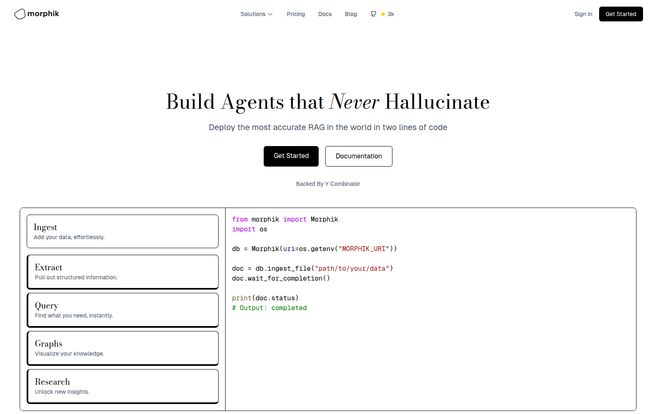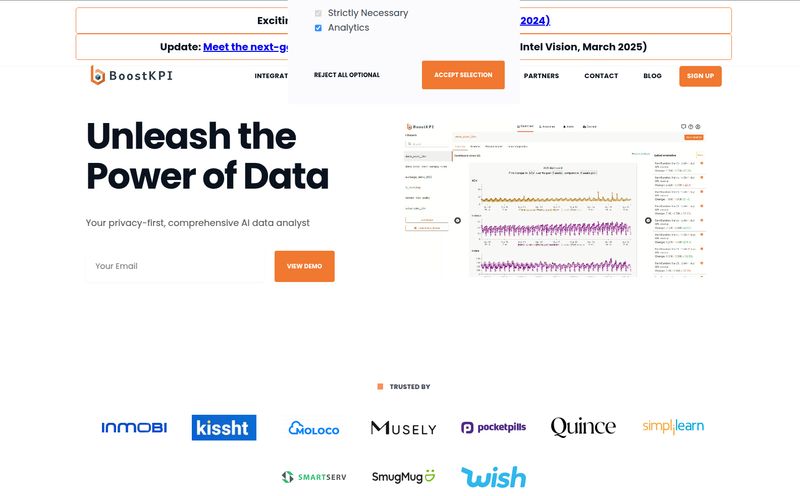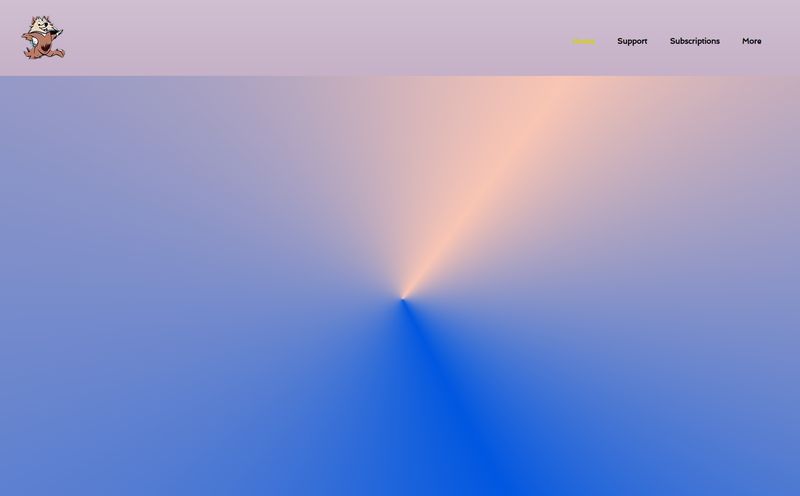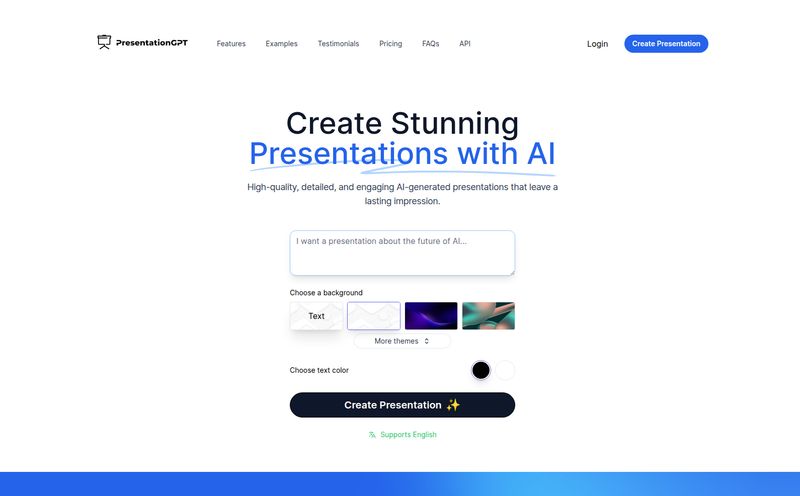Let’s have a little heart-to-heart. As someone who’s been in the trenches of SEO, data analysis, and general digital spelunking for years, I can tell you a universal truth. We spend an obscene amount of our lives searching for information. Not the fun, 'discover a new band' kind of searching. I’m talking about the soul-crushing, mind-numbing hunt through dense PDFs, labyrinthine Confluence pages, and forgotten-but-critical technical manuals. It’s the digital equivalent of being a medieval scribe, but with more eye strain.
We've all been sold the AI dream before. "Just upload your documents and ask questions!" they say. But the reality has often been… underwhelming. Clumsy, out-of-context answers. A complete inability to understand a simple flowchart. Hallucinations so wild they’d make a sci-fi author blush.
So, when I first heard about Morphik, I was skeptical. Another AI knowledge base? Groundbreaking. But then I saw their tagline: "Build Agents that Never Hallucinate." And they called it a "Perplexity for enterprise data." Okay, you have my attention. I had to see if this was just marketing fluff or if they’d actually built the tool I’ve been daydreaming about for a decade.
So What Exactly is Morphik?
At its core, Morphik is an open-source, AI-native knowledge base and research agent. That’s a mouthful, I know. Think of it like this: you have a massive, chaotic library of all your company’s most complex information—research papers, engineering schematics, legal documents, market reports, you name it. Morphik doesn't just index the words; it aims to understand the content, including the pictures and diagrams. Its big, bold claim is that it can slash the time knowledge workers (that’s us!) spend digging for docs by up to 70%. That’s not a small number. That's getting your Thursdays and Fridays back.
The Big Question: Is This Just Another RAG System?
If you're in the AI space, you've heard of RAG—Retrieval-Augmented Generation. It’s the dominant technique right now. Find relevant text chunks, stuff them into an LLM's context window, and hope for the best. It works, kinda. But it’s a blunt instrument. It’s why AI often misses the nuance that connects paragraph three on page 12 with a specific diagram on page 87. It sees text, not context.
Morphik is positioning itself as the evolution of RAG. Looking at their materials, they seem to be leaning heavily on a combination of visual-first retrieval, knowledge graphs, and a deeper ingestion process. Instead of just grabbing text snippets, it creates a more structured understanding of your data. This is where their claim of outperforming traditional RAG systems comes from. They even put out a performance graph showing a pretty dramatic difference in speed and the number of documents it can handle simultaneously. Now, I always take internal benchmarks with a grain of salt, but the direction here is what’s exciting.

Visit Morphik
This approach is what supposedly allows their agents to avoid hallucinating. If the AI has a coherent map of the knowledge instead of just a bag of sentences, it's less likely to invent nonsense. It can say "I don't know" or, even better, synthesize an answer from multiple, seemingly unrelated sources. A genuine game-changer, if true.
My Favorite Morphik Features
Digging through what Morphik offers, a few things really jumped out at me. These aren't just bullet points on a feature list; they feel like direct answers to prayers I've muttered at my screen at 2 AM.
It Actually Understands Pictures! (Visual-First Retrieval)
This is the big one for me. I've lost count of the times I’ve tried to find a specific component on a 300-page PDF schematic or understand a complex system architecture from a PowerPoint slide. Morphik’s Diagram Intelligence is designed to ingest and understand these visual elements. It can look at a flowchart and get the logic, or read a schematic and identify parts. For anyone in engineering, science, or any tehcnical field, this isn't a nice-to-have; it's the holy grail.
Open Source and Ready to Tinker
Vendor lock-in gives me hives. Morphik being open-source is a massive green flag. It means you can see how it works, customize it to your heart's content, and you’re not shackled to one company's roadmap and pricing whims. For developers, this is huge. It means you can build on top of it, integrate it deeply into your own systems via their REST API and SDKs, and contribute back if you find something to improve. It builds trust.
On-Premise for the Security-Conscious
Let's be real, no serious enterprise is going to upload its most sensitive intellectual property to a random third-party cloud. The fact that Morphik offers on-premise and bring-your-own-cloud (BYO-cloud) deployment options on their Enterprise plan is critical. It shows they understand the security and compliance needs of big organizations. Your data stays in your castle, under your control.
Let's Talk Turkey: Morphik Pricing
Alright, so how much does this magic cost? The pricing structure actually seems pretty well thought out, with clear tiers for different types of users. It's not one of those frustrating "Contact Us for a Demo" black boxes, at least not until you hit the enterprise level.
| Plan | Price | Best For | Key Features |
|---|---|---|---|
| Free | $0/month | Individuals & Exploration | 200 pages, 3 agent calls/mo, open-source access, community support. |
| Pro | $35/month | Developers & PoCs | 1,500 pages, 30 agent calls/mo, priority GPU, email support. |
| Team | $599/month | Production Use | 20GB storage, unlimited queries, dedicated instance, private Slack support. |
| Enterprise | Custom | Large-scale & Compliance | On-prem, SOC 2 / HIPAA, custom models, 24/7 support. |
Honestly, the free tier is generous enough to actually kick the tires and see if it works for you. The Pro plan at $35 feels like the sweet spot for a solo dev or a small team running a proof-of-concept. Once you get to the Team and Enterprise level, you're obviously talking about a serious commitment, but the features like dedicated instances and SSO justify the price for a production environment.
The Not-So-Perfect Parts
No tool is perfect, and it’s important to go in with eyes open. Based on their pricing and docs, the main limitations are built into the lower tiers, which is standard practice. The 200-page limit on the free plan is enough for a test but not for a real project. The shared GPU ingestion queue for free users means your documents might take longer to process during peak times. And you’ll want to watch your usage, as overage charges apply if you go beyond your plan’s limits. These aren't dealbreakers, just the realities of a freemium SaaS model.
Final Thoughts: Is Morphik Worth Your Time?
After digging in, I'm genuinely optimistic. Morphik isn’t trying to be another all-purpose AI chatbot. It’s a specialized, powerful tool aimed squarely at solving one of the most expensive and frustrating problems in the knowledge economy: finding and understanding complex information.
It feels less like a product and more like an infrastructure piece for a new way of working. The combination of open-source flexibility, true visual understanding, and enterprise-grade security options makes it a compelling package. It’s for the R&D labs, the engineering firms, the legal teams—anyone whose value is tied to their ability to navigate a sea of dense, domain-specific data.
If you’re still living in a world of endless PDF searching and wiki-diving, you owe it to yourself to give Morphik’s free tier a spin. It might just be the thing that finally lets you close some of those 57 browser tabs.
Frequently Asked Questions
- What counts as a 'page' in Morphik's pricing?
- Typically, in these kinds of systems, a 'page' refers to a standard 8.5x11 document page or a comparable block of text or data. For an exact definition, especially regarding images or dense schematics, you'd want to check their official documentation, as it can vary.
- Can I really use this on-premise with my own servers?
- Yes, but that's an Enterprise plan feature. It's designed for organizations with strict data privacy and security requirements, allowing them to run Morphik entirely within their own infrastructure.
- How hard is it to get started with the API?
- The homepage shows a Python code snippet that's just a few lines long to ingest a file and run a query. This suggests that the basic integration is designed to be very straightforward for developers familiar with using APIs.
- Is Morphik truly open source?
- Yes, the core of Morphik is open source. You can find their repository on GitHub, which allows for transparency and community contributions. The paid plans offer managed hosting, priority support, and advanced features built around that open-source core.
- What happens if I go over my page limit on the Pro plan?
- According to their pricing page, there is an overage charge once you exceed the 1,500 pages included in the Pro plan. The current rate is listed as $0.03 per extra page, so it's a predictable cost you can plan for.
- Is Morphik better than a simple vector search solution?
- It aims to be. While a vector search just finds similar-looking text or image chunks, Morphik's use of Knowledge Graphs and Diagram Intelligence is meant to provide a deeper, more contextual understanding of the information, leading to more accurate and insightful answers.



